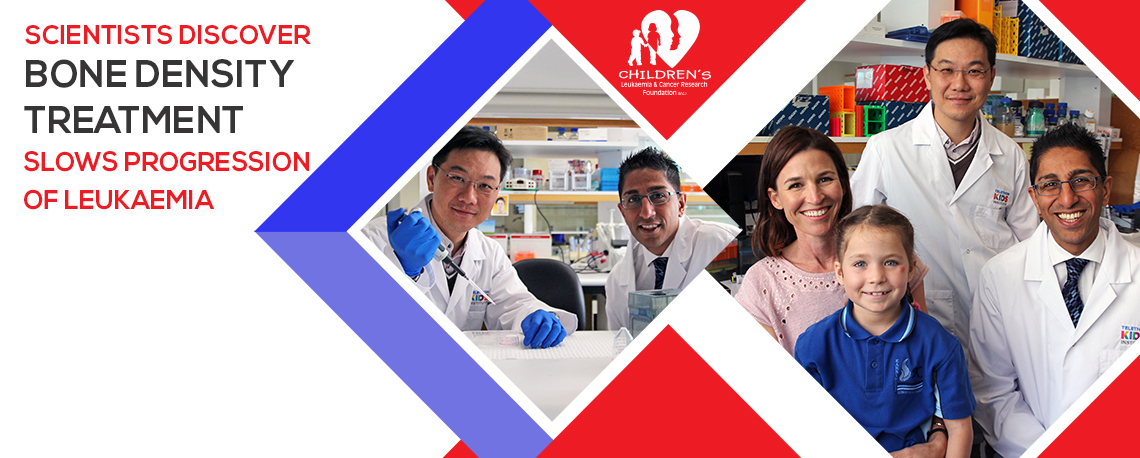
CLCRF Scientists Discover Bone Density Treatment Slows Progression of Leukaemia
Researchers at the Telethon Kids Institute who are funded by the Children’s Leukaemia & Cancer Research Foundation (Inc.) have discovered a vital key to the progression of leukaemia in children. This finding has led to a paradigm shift in how researchers think about treating patients with leukaemia. The researchers have found that treating the cancer cells as well as their environment is key.
In new ground breaking research published in the Nature journal, Leukemia, by a team of scientists, including Dr Rishi Kotecha, led by Telethon Kids Cancer Centre researcher, Dr Laurence Cheung, documented how they have identified the mechanism of bone loss that occurred during the development of leukaemia. When the microenvironment around the leukaemia cells were treated, this was able to reduce the progression of leukaemia.
The findings, while still in the pre-clinical phase, are promising and suggest that targeting the microenvironment around leukaemia cells can help fight leukaemia and also provide relief for one of its most painful side-effects, bone loss.
Acute lymphoblastic leukaemia (ALL) is the most common cancer among children and common cause of cancer-related death in those under 20 years of age. Dr Cheung’s study focused on the most common form of leukaemia in children, a subtype of ALL known as pre-B ALL.
“When we created a pre-clinical model replicating this kind of leukaemia, we witnessed substantial bone loss during the development of the cancer,” Dr Cheung said.
“We went back to the literature and found that more than a third of children diagnosed with pre-B ALL had symptoms of bone pain and skeletal defects at the time they were diagnosed – suggesting leukaemia cells can alter their surrounding environment.”
The researchers wanted to discover what was causing the bone loss, and identified a signal produced by the leukaemia cells which instructed cells in the microenvironment – known as osteoclasts – to eat away at the bone.
“Then we thought, what if we stop the bone-eating cells from eating the bone away – will this have an impact on the development of leukaemia?” Dr Cheung said.
The team used a commercially available drug called zoledronic acid – already known to be safe for children and used to treat brittle bone disease – to target the cells in the microenvironment around the leukaemia cells.
“Importantly, we found that this not only compensated for the leukaemia-dependent bone fragility, but also reduced leukaemia progression,” Dr Cheung said.
He said although similar thinking had been applied previously to cancer in adults, the finding offered an exciting new treatment angle for children.
“To date, the main strategy for cancer therapy in children has focused on targeting malignant cells with chemotherapy, which is toxic for the leukaemia cells but also toxic for the patient.
“Our finding that the cells surrounding the leukaemia cells can contribute to treatment failure or success has led to a paradigm shift.
“It’s not going to replace chemotherapy, but we propose that using chemotherapy and treating the microenvironment at the same time will have more benefit than just the chemotherapy by itself.
“What it really shows is that it’s important to look at that whole picture, and not just the leukaemia cells, because the leukaemia cells and the cells in the surrounding microenvironment are all talking to each other.”
The next step of their study is to expand the research using a similar treatment on other sub-types of the same kind of leukaemia to see if a similar impact could be achieved and to ensure that zoledronic acid was compatible with current chemotherapy agents.
“There’s quite a way to go yet, but it’s exciting to think about the paradigm shift this represents for children’s leukaemia, as well as the dual benefits it offers: both slowing the progression of the leukaemia, and mitigating this really common and painful side effect suffered by children with leukaemia, and that is the bone loss,” Dr Cheung said.
The full paper, New therapeutic opportunities from dissecting the pre-B leukemia bone marrow microenvironment, can be read here.
The CLCRF is proud to fund key groundbreaking research in leukaemia and look forward to further exciting developments. If you would like to give towards child cancer research please donate to the CLCRF.
